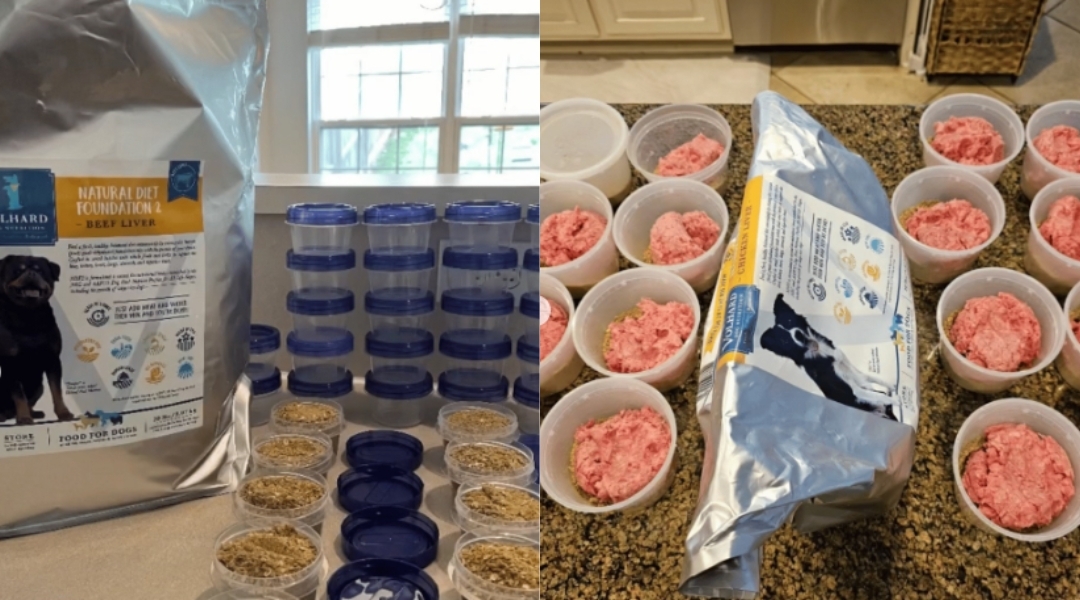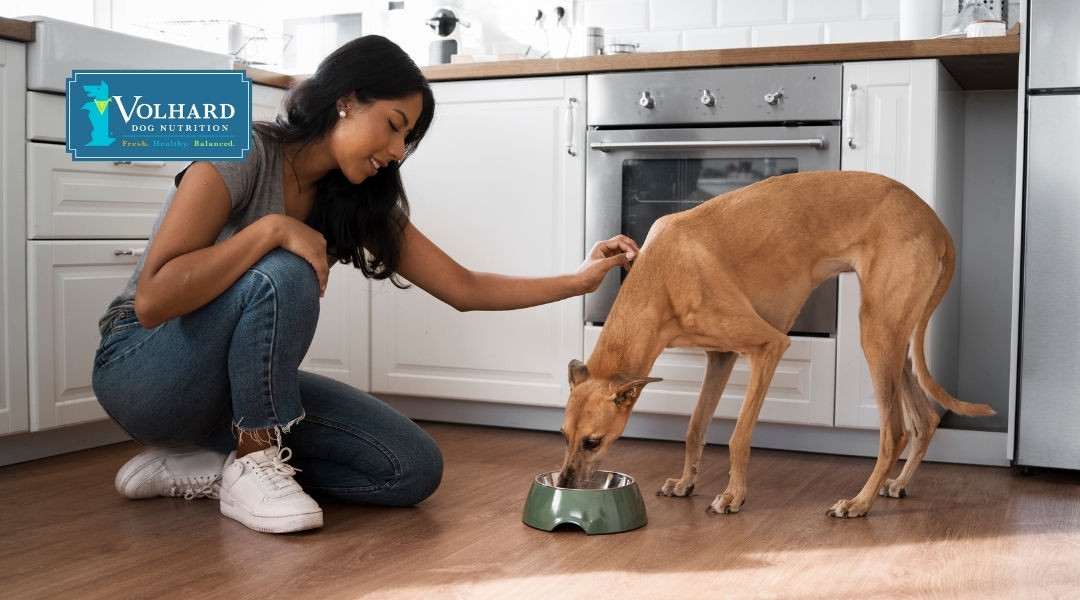8 Ways to Properly Store Your Dog's Food
Posted by Volhard Dog Nutrition on Jul 10th 2025
You put care into choosing the right food for your dog, but what happens after you bring it home matters just as much.
Without proper storage, even the best kibble or raw diet loses its nutritional punch, turns rancid, or grows harmful bacteria long before the expiration date.
Whether scooping kibble from a bag or defrosting raw meals, our eight practical tips will help you preserve freshness, lock in nutrition, and keep your dog’s meals as safe and wholesome as the day you bought them!
What you will learn:
- The importance of proper dog food storage for preserving nutritional value and ensuring your dog's health.
- Practical tips and best practices for storing both kibble and raw diets to maximize freshness and safety.
- How to identify signs of spoilage and choose safer food options and preservatives for your dog's meals.

Why Proper Storage of Dog Food Matters
Properly storing your dog’s food directly impacts your pet’s health and well-being.
When food is exposed to air, heat, or moisture, it begins to break down in ways that aren’t always visible but can be harmful over time.
One of the biggest concerns is rancid fat.
The fats used in many commercial dog foods, especially those from poultry or fish, are highly prone to oxidation. As these fats break down, they lose nutritional value and produce harmful compounds that cause digestive upset, skin issues, organ strain, or even increase the risk of long-term illness.
Nutrient degradation begins the moment a food package is opened. Essential vitamins like A, E, and D are particularly sensitive to oxidation. As they break down, your dog does not receive the full nutritional benefits listed on the label, even if you're feeding the right amount.
Proper storage practices preserve the integrity of your dog’s food, protecting its taste, safety, and nutritional value in every scoop.
1. Keep Kibble in Its Original Packaging
It may be tempting to pour your dog’s kibble into a plastic storage bin for easy scooping, but this common habit can do more harm than good.
This is especially true for our premium raw diets like NDF2 or Rescue, which are packed with fresh, high-quality ingredients. Proper storage is essential to preserve nutrient integrity and prevent contamination.
Original dog food bags are designed to preserve freshness. They contain grease-resistant liners and antioxidant barriers that help protect the fats in the food from oxidation. These built-in protections are lost the moment dog food is transferred to another container.
Even when cleaned regularly, plastic bins develop microscopic scratches that trap oil and food residue, a breeding ground for bacteria.
Keep the food in its original bag and place the bag inside the container rather than pouring it directly.
2. Use Kibble Within 2–3 Weeks of Opening
While an unopened bag of kibble or raw food stays shelf-stable for a year or more, the story changes once the bag is opened.
Each time you break the seal, oxygen, moisture, and light begin to degrade the fats in the food, particularly polyunsaturated fats found in poultry and fish-based recipes. This leads to oxidation, which causes food to become rancid and destroys essential nutrients.
Even if the food still looks and smells normal, the nutritional quality may already be compromised. That’s why using dog food within 2 to 3 weeks of opening is essential.
To make this manageable, choose smaller bag sizes if you have a small dog or your pet eats slowly. Always seal the bag tightly between uses, using the built-in closure or a clip to minimize air exposure.

3. Store Food in a Cool, Dry Location
Heat and humidity are major culprits when it comes to accelerating spoilage. When stored in warm or damp environments, dog food breaks down faster, and moisture invites mold or bacterial growth, even inside sealed packaging.
Keep your dog’s food in a pantry or cupboard away from direct sunlight, stoves, laundry rooms, or windows to protect it. Instead, choose a cool, dry spot with a stable temperature, ideally below 80°F.
4. Avoid Dog Food With Added Fish Oil
Fish fats, especially Omega-3 fatty acids, are highly unstable. They oxidize quickly, even in sealed bags, which means the food could be rancid before you open it.
Once exposed to air, fish oil degrades rapidly, producing foul-smelling compounds and losing its nutritional value. This makes the kibble unpalatable and risks digestive upset and long-term health issues.
Adding a fresh, high-quality fish oil supplement at mealtime is safer than relying on kibble with fish oil. Our krill oil is stable and provides cleaner, more bioavailable sources of Omega-3s.
5. Know Your Preservatives
Many commercial kibbles use synthetic preservatives like BHA, BHT, and ethoxyquin to extend shelf life.
While these additives help prevent fats from spoiling, they’ve also been linked to health concerns, including liver damage and allergic reactions.
Safer options include natural preservatives such as mixed tocopherols (a form of vitamin E), rosemary extract, and citric acid. These alternatives are gentler on your dog’s system but don’t last as long, meaning food preserved naturally requires more careful handling.

6. Refrigerate or Freeze Raw and Fresh Foods
Proper cold storage is non-negotiable if your dog eats a raw or fresh diet, including our Volhard diets.
For short-term use, keep fresh meals in the refrigerator for no more than 2–3 days. Anything beyond that should be frozen. Freezing raw food is the best way to preserve its long-term safety and nutritional value.
Label packages with the date you freeze them, rotate older items forward, and thaw only what your dog can eat within a day or two. These habits reduce waste and keep your dog’s diet as fresh and safe as possible.
7. Use Vacuum Sealing for Long-Term Storage
If you’re storing raw, fresh, or dehydrated dog food in bulk, vacuum sealing is one of the most effective ways to preserve freshness and nutritional value.
By removing air from the packaging, vacuum sealing prevents oxidation and protects against freezer burn, keeping food safe and palatable for longer.
8. Monitor for Signs of Spoilage
Even with the best storage methods, checking your dog’s food regularly for signs of spoilage is essential.
Watch (and smell) for these warning signs:
- Musty, sour, or “off” odors.
- Greasy or sticky residue.
- Visible mold or discoloration.

Volhard Prioritizes Freshness to Protect Your Dog’s Health!
Every Volhard formula is designed with your dog’s wellness in mind. Volhard diets make it easy to preserve nutrients, avoid spoilage, and deliver real, wholesome meals every time.
For more advice on dog nutrition, health, and training, contact us and check out our other blogs!
Volhard Dog Nutrition and its expert canine nutrition coaches offer online consultations to help more dog parents discover why and how to feed their dogs the healthiest foods!
Speaking to a Volhard canine nutrition coach will help you understand the inseparable relationship between healthy food, a healthy body, and a healthy mind.
If you want to contact one of our Volhard canine nutrition coaches, don't hesitate to access our consultation page!
References
- Keenan, Joanne. "How Long Does Kibble Last? - Dogs Naturally." Dogs Naturally - Natural Dog Health And Nutrition, 13 Dec. 2021, www.dogsnaturallymagazine.com/throw-dogs-kibble-away/. Accessed 14 May 2025.
- Morelli, Giada, et al. "A survey among dog and cat owners on Pet Food Storage and preservation in the households." Animals, vol. 11, no. 2, 21 Jan. 2021, p. 273, https://doi.org/10.3390/ani11020273. Accessed 14 May 2025.

